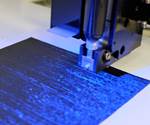Demonstrator shows potential for graphene-enhanced composite tooling
U.K.-based collaborative project demonstrates lower-cost, graphene-enhanced composite tooling for aerospace use.

A recently completed U.K. government-funded NATEP technology program aimed to demonstrate the viability of new materials development with potential for significant time and cost savings in aerospace composite tooling design.
SHD Composites Ltd. (SHD, Sleaford, U.K.), working closely with project partners including Composite Tooling and Engineering Solutions Ltd. (CTES, Matlock, U.K.) and Applied Graphene Materials plc (AGM, Redcar & Cleveland, U.K.), reports that it has developed a prototype tooling material that combines cure at initial low temperatures (80-90°C) with the ability for post-cure to achieve a maximum service temperature in excess of 300°C. This cure flexibility enables the use of low-cost pattern materials and progression to a final production tool without the need for an expensive, time-consuming and accuracy-losing intermediate tool phase, or manufacture of an expensive, metallic master model, SHD says.
The tooling resin chemistry has been enhanced by the addition of AGM’s A-GNP35 graphene nanoplatelets, which enhance the matrix toughness and provide additional resilience against variations in processing conditions and resin micro-cracking over repeated production cycles. The graphene can be added into the bulk tooling material or discreetly targeted at critical regions by means of AGM’s Structural Ink printing technology.
The new material has been developed specifically to enable cost savings for major aerospace programs. The demonstrator was a 10-meter-long carbon fiber-reinforced polymer (CFRP) automated fiber placement (AFP) mandrel tool, engineered by CTES (and manufactured by Retrac Composites Ltd. in Swindon, U.K.) and was chosen as representative of the industry’s latest and highly demanding requirements.
The project team says the outcome of the demonstrator project was successful, resulting in a fully functional composite tool demonstrating the potential for significantly lowered costs while maintaining high performance.
As well as proving out production robustness, development work has also progressed to the processing of the material out of autoclave, as well as the potential for applications in prototype tooling for high-performing thermoplastic materials.
The team says it will release more details over the next several weeks through industry forums.
Related Content
-
COMPINNOV TP2 project promotes use of thermoplastics in aerospace
Completed in 2023, COMPINNOV TP2 explored thermoplastic composites, enhancing the understanding between prepregs and production methods to foster the potential for French aerospace innovation.
-
SmartValves offer improvements over traditional vacuum bag ports
Developed to resolve tilting and close-off issues, SmartValves eliminate cutting through vacuum bags while offering reduced process time and maintenance.
-
VIDEO: One-Piece, OOA Infusion for Aerospace Composites
Tier-1 aerostructures manufacturer Spirit AeroSystems developed an out-of-autoclave (OOA), one-shot resin infusion process to reduce weight, labor and fasteners for a multi-spar aircraft torque box.

.jpg;width=70;height=70;mode=crop)













